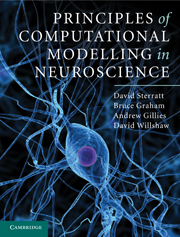Book contents
- Frontmatter
- Contents
- List of abbreviations
- Preface
- Acknowledgements
- Chapter 1 Introduction
- Chapter 2 The basis of electrical activity in the neuron
- Chapter 3 The Hodgkin–Huxley model of the action potential
- Chapter 4 Compartmental models
- Chapter 5 Models of active ion channels
- Chapter 6 Intracellular mechanisms
- Chapter 7 The synapse
- Chapter 8 Simplified models of neurons
- Chapter 9 Networks of neurons
- Chapter 10 The development of the nervous system
- Chapter 11 Farewell
- Appendix A Resources
- Appendix B Mathematical methods
- References
- Index
Chapter 5 - Models of active ion channels
Published online by Cambridge University Press: 05 June 2012
- Frontmatter
- Contents
- List of abbreviations
- Preface
- Acknowledgements
- Chapter 1 Introduction
- Chapter 2 The basis of electrical activity in the neuron
- Chapter 3 The Hodgkin–Huxley model of the action potential
- Chapter 4 Compartmental models
- Chapter 5 Models of active ion channels
- Chapter 6 Intracellular mechanisms
- Chapter 7 The synapse
- Chapter 8 Simplified models of neurons
- Chapter 9 Networks of neurons
- Chapter 10 The development of the nervous system
- Chapter 11 Farewell
- Appendix A Resources
- Appendix B Mathematical methods
- References
- Index
Summary
There are many types of active ion channel beyond the squid giant axon sodium and potassium voltage-gated ion channels studied in Chapter 3, including channels gated by ligands such as calcium. The aim of this chapter is to present methods for modelling the kinetics of voltage-gated and ligandgated ion channels at a level suitable for inclusion in compartmental models. The chapter will show how the basic formulation used by Hodgkin and Huxley of independent gating particles can be extended to describe many types of ion channel. This formulation is the foundation for thermodynamic models, which provide functional forms for the rate coefficients derived from basic physical principles. To improve on the fits to data offered by models with independent gating particles, the more flexible Markov models are introduced. When and how to interpret kinetic schemes probabilistically to model the stochastic behaviour of single ion channels will be considered. Experimental techniques for characterising channels are outlined and an overview of the biophysics of channels relevant to modelling channels is given.
Over 100 types of ion channel are known. Each type of channel has a distinct response to the membrane potential, intracellular ligands, such as calcium, and extracellular ligands, such as neurotransmitters. The membrane of a single neuron may contain a dozen or more different types, with the density of each type depending on its location in the membrane.
- Type
- Chapter
- Information
- Principles of Computational Modelling in Neuroscience , pp. 96 - 132Publisher: Cambridge University PressPrint publication year: 2011



